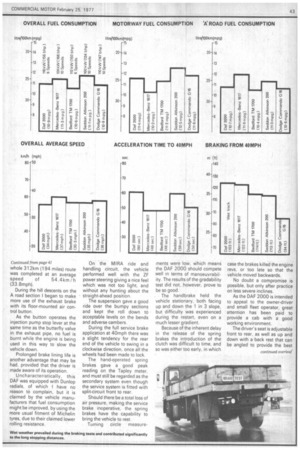Continued from page 41
Page 47

If you've noticed an error in this article please click here to report it so we can fix it.
whole 312km (194 miles) route was completed at an average speed of 54,4km/h (33.8mph).
During the hill descents on the A road section I began to make more use of the exhaust brake with its floor-mounted air control button.
As the button operates the injection pump stop lever at the same time as the butterfly valve in the exhaust pipe, no fuel is burnt while the engine is being used in this way to slow the vehicle down.
Prolonged brake lining life is another advantage that may be had, provided that the driver is made aware of its operation_ Uncharacteristically, this DAF was equipped with Dunlop radials, of which I have no reason to complain, but it is claimed by the vehicle manufacturers that fuel consumption might be improved, by using the more usual fitment of Michelin tyres, due to their claimed lower rolling resistance. On the MIRA ride and handling circuit, the vehicle performed well with the ZF power steering giving a nice feel which was not too light, and without any hunting about the straight-ahead position The suspension gave a good ride over the bumpy sections and kept the roll down tO acceptable levels on the bends and adverse cambers.
During the full service brake application at 40mph there was a slight tendency for the rear end of the vehicle to swing in a clockwise direction, once all the wheels had been made to lock.
The hand-operated spring brakes gave a good peak reading on the Tapley meter, and must stilt be regarded as the secondary system even though the service system is fitted with split-circuit front to rear.
Should there be a total loss of air pressure, making the service brake inoperative, the spring brakes have the capability to bring the vehicle to rest.
Turning circle measure
ments were low, which means the DAF 2000 should compete well in terms of manoeuvrability. The results of the gradability test did not, however, prove to be so good.
. The handbrake held the vehicle stationary, both facing up and down the 1 in 3 slope, but difficulty was experienced during the restart, even on a much lesser gradient.
Because of the inherent delay in the release of the spring brakes the introduction of the clutch was difficult to time, and so was either too early, in which case the brakes killed the engine revs, or too late so that the vehicle moved backwards.
No doubt a compromise is possible, but only after practice on less severe inclines.
As the DAF 2000 is intended to appeal to the owner-driver and small fleet operator, great attention has been paid to provide a cab with a good working environment.
The driver's seat is adjustable front to rear, as well as up and down with a -back rest that can be angled to provide the best continued overleaf.






























































































